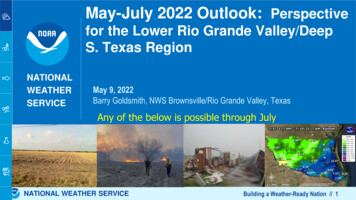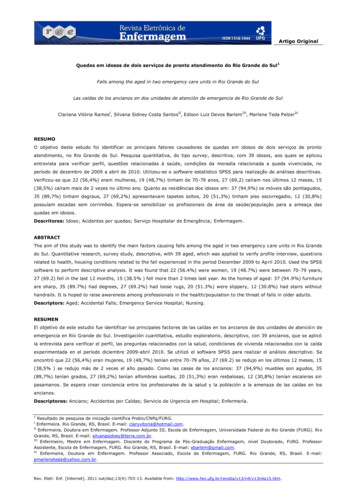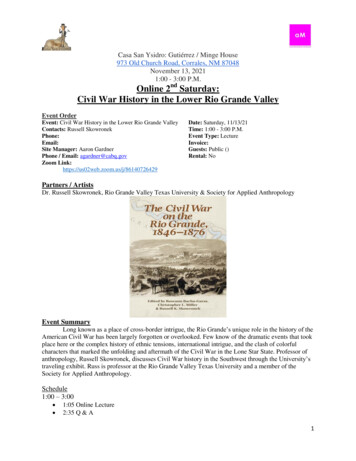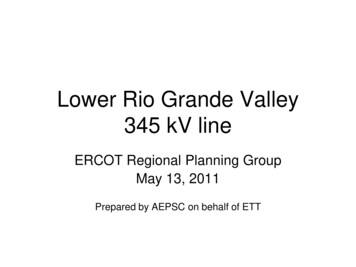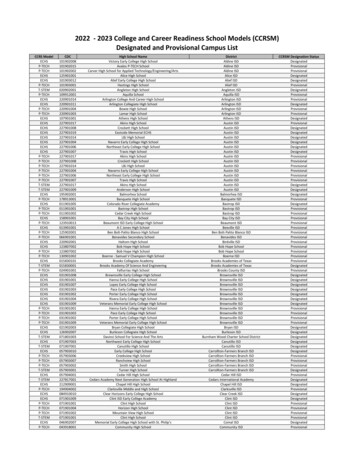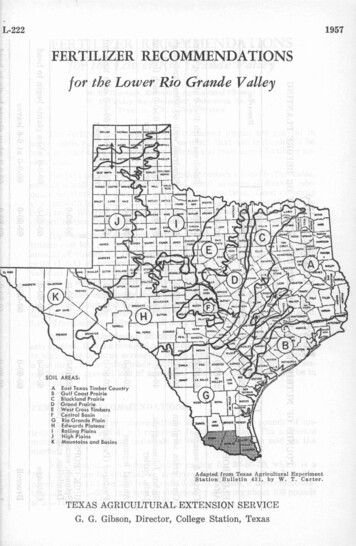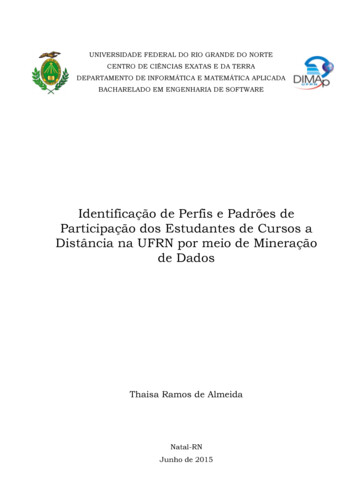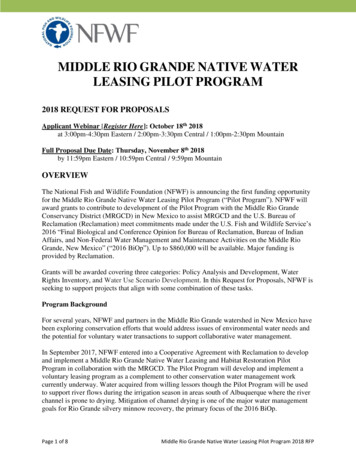
Transcription
Lower Rio Grande Valley-Brownsville SeawaterDesalination Demonstration ProjectExecutive Summary1IntroductionNo region of Texas has as great a need for additional water supplies or is as limited with regardto new supply options as the Texas-Mexico border. No region in Texas has the international,environmental, demographic or the economic challenges that this area possesses. It is a highgrowth area with an already overcommitted central water supply (the Rio Grande) that has beenplaced at further risk by international treaty compliance issues. It is a region struggling to retainexisting jobs, including those in the agricultural sector, and to expand its economic base toinclude new economic activity. Its environmental challenges are complicated by the lack ofwater available for water uses traditionally identified with the natural environment and its needs. Because of the Lower Rio Grande geographic location, the only viable and dependablemajor source of new water to sustain, continue growth in the region is the Gulf of Mexico. Furthermore, the quality of water available to many water users continues to degrade,increasing the cost of treatment and making desalination of seawater more feasible.All of these challenges could be eased by securing a new, drought proof, high quality watersupply and by the right public policies and actions (including financial assistance) associatedwith this supply source. This water supply could be desalinated seawater.The Lower Rio Grande area is better positioned to take advantage of this new supply than anyother area of the state by virtue of its needs and its ability to find direct and indirect markets forthis water. Water rights management in the Amistad-Falcon Reservoir system serving this areaallows for enhanced ability to provide water supplies in ways unique to this part of Texas. Noother region has the ability to internally “market” water made available from such a project.There is also the possibility to provide water to Mexican cities with even greater needs, shouldthe right financial, political and institutional arrangements be reached. Providing such servicecould create an indirect subsidy for U.S. water users by creating larger economies of scale,thereby reducing the unit cost of water for this project. Mexican governmental entities shouldbear the full cost of desalinated water service should they be allowed to participate in the project.As Figure E-1 shows, all users gain by economies of scale. As the scale of the project isincreased, the unit cost to produce water is reduced. All users benefit from increased1Prepared by Dannenbaum Engineering Corporation (Professional Engineer seal of Tom Arndt) and URSCorporation for the Brownsville Public Utilities Board under a grant from the Texas Water Development Board,TWDB contract number 2004-483-515.1
participation whether these users are other regional entities in the Texas portion of the region orsome combination of Texas and Mexican communities.Figure E-1 Unit Cost Relative to Project SizeSeawater Desalination Economies of Scale: /1000 gallons4.003.00 2.001.000.0002550MGD Treatment Plant Capacity75100Regional Needs/OptionsThe recently completed Rio Grande Water Availability Model (WAM) identified available firmsupplies in drought of record conditions and current treaty compliance circumstances asapproximately half of the demand for water. While municipalities are given priority for thedelivery of water in the Lower Rio Grande, the consequences of this shortfall are reducedavailability to irrigators, industry and the environment. Some municipalities, however, couldalso see their supply impacted since many municipal users secure their water through deliveryarrangements with irrigators. Often, the “push water” needed to fill canals and allow for thetransportation of municipal water is provided by irrigation water, which typically is the muchgreater volume being transported in the canal systems. If there are insufficient volumes ofirrigation water being transported in the canals, the ability to deliver water to manymunicipal users may be compromised.The current water deficit in the Lower Rio Grande Water Supply Planning Region (RegionM) exceeds 1,000,000 acre-feet per year. Even with all identified water management strategiesimplemented, Region M will continue to have a water deficit for the foreseeable future. Further,2
the existing water supply from the Rio Grande in Region M is projected to decline over25% in the next 50 years.In the current regional water plan, the primary option for securing additional new waterfor municipal, industrial and steam electric purposes in the area of the Lower Rio GrandeRegional Planning Group is the transfer of water rights from irrigated agriculture. Thistransfer would further exacerbate the deficit for agriculture identified above, and furtherreduce the economic viability of that important economic sector.New, local water supply options are limited and imported water supplies are subject tointense competition from other needy municipal users outside the Lower Rio Grande region.Imported water also suffers from the associated high cost of delivery. Locally available brackishgroundwater is one option to bridge this gap but is, by definition, a finite resource and its extentnot fully known. Supplies of brackish groundwater are still being characterized within theregion.New surface water supplies identified from within the region are limited to the proposedBrownsville Weir, which, while technically viable, requires bi-national approval to proceed toimplementation. The prospects of bi-national approval for the weir project are far from certain.New supplies from outside the region are distant and coveted by other potential users.Potentially available new surface water supplies in the Guadalupe and Colorado Basins arelargely earmarked for Bexar County or in-basin users. Potential seawater desalination projects inCorpus Christi and Freeport are even farther from potential users than the proposed project ofthis study.The only major new water supply source for the Rio Grande Basin that will satisfy theidentified needs, have certain availability and provide a drought-proof supply isdesalinated seawater. Desalination can be easily viewed as the most feasible technology tosatisfy the growing industrial and domestic water demands while maintaining current suppliesfor agriculture in the region. This proven technology will provide the region with a droughtindependent source that can contribute to the growing and existing needs.The major water user types that could directly benefit from a seawater desalination projectinclude municipal, industrial and steam electric users. The regional demand for new watersupplies for these sectors is approximately 200mgd or some 184,000 acre-feet per year by2050. No other identified supply source can satisfy this demand for new water.Local demand in the Brownsville system makes up a major portion of the need in the early yearsof the project and is a key foundation for project viability. However, in the long term themajority of the project demand is from the rest of the region. (See Figure E-2.) This is truly aregional project with the potential to address regional needs.In addition to the new supplies to regional municipal and industrial users, positive impacts toagricultural users and environmental flows are indirectly benefited by the return flows ofdesalinated water, if so dedicated. The Rio Grande River environment could also be enhancedby dedicating some of the surface water currently used for municipal purposes, which couldremain in the river due to the water made available by this project.3
Such an undertaking can benefit the whole region’s industry, agriculture and domestic use andprovide for increased environmental flows. Even though the project will not meet the total NetRegional needs over the next 50 years, the project will be a fundamental element in an overallstrategy to satisfy the region's future water demands.Figure E-2 Net Regional Needs250225200150REGIONALNEEDS12510075NETMILLION GALLONS PER DAY 0203520302025202020152010200520000YEARNote: Net Regional Needs are the Sum of Municipal and Steam Electric Power WaterUser Deficits from the Region M Water Plan.4
3.Regional PartnershipsThe major stumbling block to implementation of a seawater desalination project is ultimatedelivery cost. Given the present water rate structure, subsidies are required for any seawaterdesalination project in Texas and throughout the United States. The Lower Rio Grande projectproposed by Brownsville has key competitive advantages over other regions that will help limitthe subsidy requirement. As described above, the pronounced water supply deficit, associatedeconomies of scale and the presence of efficient and effective delivery mechanisms will facilitatethe project's implementation.Securing additional regional partnerships is critical to the project’s success. Some forty-eightcommunities within the region have supported the desalination project in concept. Some of thesecommunities—like Brownsville—could be served directly with water from the desalinationplant. Other communities as far away from the project as Eagle Pass or Laredo could receiveindirect benefits from the project by securing water freed up from use by project “direct deliverycustomers.” Again, this management tool is available to the region because of the uniquesystem, hydrology and legal characteristics of water supplies in the Lower Rio Grande.Figure E-3 Lower Rio Grande Valley Water Planning (Region M) Potential Service Area5
Description of ProjectThe project consists of the water desalination plant initially scaled to 25 MGD, the finished watertransmission line and offsite storage, which integrates into the Brownsville PUB system, and thebrine disposal system that safely discharges concentrate into the Gulf of Mexico. As additionalcustomer cities are added into the project, treatment plant size, associated intake structures,additional pipeline capacities and other infrastructure will be expanded.Figure E-4 Project LayoutWater Treatment: A detailed alternatives analysis was conducted for all major treatmentprocesses and plant components. (Please refer to Section 3 of the report for a full discussion ofthe alternative analysis, the methodology used to conduct the analysis, and individual alternativesconsidered by the analysis.) In summary, the alternative analysis used weighted evaluationcriteria for each alternative. Viable options were identified and a score assigned for eachevaluation criteria. The option receiving the highest total weighted score was then selected as therecommended alternative. Based on the alternatives analysis, the following systems wereselected for the conceptual design: Seawater Intake - Side channels from the Brownsville Ship Channel with screened intakeassemblies;Pretreatment System - Ballasted flocculation, dual media filtration, cartridge filtration;Primary Treatment - High pressure reverse osmosis with energy recovery;6
Post-Treatment - Pebble lime stabilization, on-site generated sodium hypochloritedisinfection;Solid Handling - Flocculation basins, gravity thickeners, belt filter presses;The above described system would reliably provide a high quality potable water complying withall current and anticipated standards for drinking water quality. It is also believed that permitscould be obtained for the plant and concentrate disposal with appropriate study and permitapplications.Figure E-5 Conceptual Site PlanFinished Water Transmission: The finished water transmission main will leave the pump stationlocated at the treatment plant site and cross State Highway 48 (SH 48) to the north. It will thenparallel SH 48 and run westerly to the proposed offsite storage near FM 511. From this point,the finished water will be pumped into the Brownsville system and in future phases, to othermunicipalities.Brine Disposal: Several brine disposal alternatives were considered including industrial waterreuse, ocean outfall into the Gulf of Mexico, discharge to the Brownsville Ship Channel,evaporation ponds, and deep well injection. Due to extreme logistical, environmental, and/orcost feasibility reasons, the viable options that could potentially be used for brine disposal forthis project would be limited to an ocean outfall or a deep well injection solution. While both ofthese options can be considered in further detail in subsequent phases, conceptual level costing7
has indicated that an ocean outfall would be the most cost-effective approach for themanagement of this stream, especially as plant capacity is expanded through time. It should benoted that it is a foregone conclusion that additional studies and evaluations will be needed toproperly support any disposal option. For the purpose of this initial conceptual-level study, theocean outfall was adopted in order to address this important project component. The safety andreliability of offshore pipelines has been documented from the long history and the experience ofthe engineering community.Power Generation: At the Statement of Interest and scoping phase of the project, it was believedby the project team that significant synergies could be realized from co-locating a powergeneration facility with the desalination plant. Since it was believed that a need existed for newgeneration capacity in the region, it made sense to consider locating these facilities adjacent toone another. It was believed that locating the power plant adjacent to the water plant would offerlower cost power for the water treatment plant and help ease the concentrate disposal problem byproviding water for dilution.Once the study was underway, it became clear that co-locating the power and water plants wouldneither reduce the power rate to the water treatment plant nor assist with the concentratedisposal, both previously assumed to offer significant synergies. There are still some synergies tobe gained from co-locating the two plants, such as pre-heating the feedwater for the watertreatment plant and demineralized make-up water for the power plant. These synergies, however,are small compared to what was originally anticipated.Since there are limited synergies between the power and water facilities, the projects shouldlargely be viewed independently. Should there be demand for both projects, there are argumentsin favor of co-locating the facilities; however, neither one of these projects depends on the otherfor viability.Regional Partnership OpportunitiesThe implementation of the proposed seawater desalination demonstration project should bephased so as to reduce operating costs and take advantage of existing supplies of lower pricedwater (like brackish groundwater) while they are available. The following phasing concept isproposed only for demonstration purposes and no communities have made firm commitmentsto such a proposal. However, it demonstrates a feasible series of options to address criticalregional concerns. (It is hoped that as a result of this study, further discussions with otherpotential regional teaming partners could progress.) Preliminary concepts for phasing wouldappear to be as follows: Phase I (2010-2020)—direct delivery within the Brownsville system with water supplytrades to other communities within the region. Desal use and available water for tradewould be further phased in over time, as demand grows. Water trades could help offsetsome of the costs of providing desalinated seawater. Environmental enhancements fromunused river water, high quality wastewater return flows or some combination of the twosources could be dedicated to maintaining a base level of instream flows forenvironmental health considerations in the Rio Grande.This project could serve8
additional users and free up some 12,600 ac-ft of water supply for trades elsewhere in theregion. Phase II (2020-2030)—expanded direct deliver and associated expanded water trades.The PUB would not need all of the water from Phase II capacity of the DesalinationPlant. A transmission pipeline to Harlingen could deliver water to five additionalcommunities that will need additional water in 2020. In concept this delivery could be apipeline from the treatment plant to customers along US Highway 77 to Harlingen. Phase III (2040-2050). The need for the construction of Phase III would be the waterdemands in Hildalgo County. A transmission pipeline to Pharr could deliver water toseven communities that will need additional water in 2030. The need for the construction of Phase IV would be the water demands in McAllen. Atransmission pipeline to McAllen could deliver water to that community which will needadditional water in 2040.In addition to the desalinated seawater supplied directly through the project, a net of nearly50,000 acre-feet of additional Rio Grande surface water could be traded to communities forwhich direct desalinated seawater is not a viable option (primarily because of the distance fromthe source).Greater specificity of phasing opportunities, partnerships and timelines will need to be developedas the project moves into subsequent stages of the implementation process and as communitiesconsider both their own internal needs and project costs and subsidy levels.Financial Analysis/Financial Mechanism RecommendationsImplementing any new technology provides both opportunities and challenges. The desalinationdemonstration project is no exception. The opportunity is clear: a viable supply of new waterthat is a cost-effective alternative to other new regional supply options. The challenge is that likeall viable new supplies, the cost will exceed the average cost that the region currently pays;though not what the region must pay if it wants to expand the supply available to it.Like all of the demonstration desalination projects this project will likely require an externalfunding source in addition to revenues provided by local ratepayers to achieve financial viability.The exact amounts, timing and overall manner of that support cannot be precisely ascertainedwithout further analysis to optimize the project’s configuration, production levels and timing ofphasing. Firm agreements with regional partners (which can only be made after all financialinformation is available) will determine the phasing of implementation and unit cost of waterproduced.9
Table E-1 Total Project CostsPhase I - 25 MGDDesalination Plant 90,167,000Concentrate Discharge System 30,583,000Finished Water TransmissionSystemProject Implementation CostsTotal Capital Costs 9,232,000 21,406,000 151,388,000However, given these caveats, it should be noted that the costs for water from this project arehighly competitive with other new sources and with other seawater desalination projects fromaround the U.S. The cost per 1000 gallons without external subsidy is anticipated to be in the 2.36 to 2.44 range during the first project phase. These numbers should be viewed aspreliminary for the reasons noted above.Further reducing costs through subsidies is necessary to make the project affordable. Suchsubsidies would have to come from government entities. It is highly unlikely that private watercompanies could provide such subsidies, thereby limiting their ability to implement such a10
project on their own. We know of no seawater desalination project that operates in the U.S.without some form of significant government subsidy.Subsidies may come in several forms: direct grants to offset capital or operating costs, lowinterest loans and deferred payment of capital costs by project owners and customers (until theproject’s customer base is sufficient to contribute all or part of the deferred payment over time).Some direct grant subsidy will likely be needed to move the unit cost for water for this projectmore in line with current average regional water costs (though the amount will depend onassumptions for the cost of new or replacement supplies). The exact magnitude of this directsubsidy will depend on other factors such as customer base, actual construction costs, etc.The primary grant and subsidized loan mechanisms would be from bi-national institutions (theBECC or NADBank), from federal agencies (Bureau of Reclamation, U.S. Corp of Engineers,etc.) or the State of Texas through the Texas Water Development Board.Further, less costly (to the government) is deferral of payments. These would have to be coupledwith subsidies, but could reduce the near-term and long-term amounts of direct grant subsidies ifproperly structured to reflect ultimate customer bases for the project.ScheduleThe schedule below identifies the earliest possible completion of the Phase I project. Thisschedule anticipates beginning the project in the fall of 2005. Several factors could affect theschedule including environmental permitting, and timing and amount of financing.11
SummaryThe Lower Rio Grande Regional Seawater Desalination project offers the unique opportunity toassist all regional users with their water supply challenges. The project is the only major newwater supply identified that can bring the volumes of new supplies to impact all water users inthe region. Its costs are highly competitive with other potential supplies from outside of theregion and with other desalination projects in the U.S. The region also possesses advantagesover other desalination demonstration projects under Governor Rick Perry’s SeawaterDesalination initiative. It’s unique regional needs, lack of practical alternatives, hydrology, andinstitutional arrangements that allow for water trading throughout the region, afford it anopportunity to succeed not possessed by the other demonstration projects.The successful implementation of this project will be a function of State and/or Federalgovernmental financial subsidies that will have to be secured. There are no desalination plantswithin the United States that currently operate without significant government subsidies.12
The Lower Rio Grande area is better positioned to take advantage of this new supply than any . system, hydrology and legal characteristics of water supplies in the Lower Rio Grande. Figure E-3 Lower Rio Grande Valley Water Planning (Region M) Potential Service Area 5.
